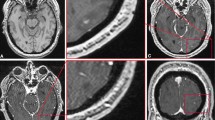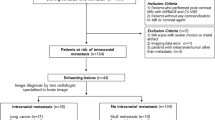Abstract
Introduction
Gadolinium-enhanced magnetic resonance imaging (MRI) is the gold standard for cerebral staging in thoracic oncology. We hypothesize that a minimalist examination, consisting of a single contrast-enhanced T1-weighted three-dimensional gradient-echo sequence (CE 3D-GRE), would be sufficient for the cerebral staging of nonsymptomatic lung cancer patients.
Methods
Seventy nonsymptomatic patients (50 % men; 62 years ± 10.2) referred for cerebral staging of a lung cancer were retrospectively included. All underwent a standard 3 T MRI examination with T1, FLAIR, T2* GRE, diffusion, and CE 3D-GRE sequences, for a total examination time of 20 min. The sole CE 3D-GRE (acquisition time: 6 min) was extracted and blindly interpreted by two radiologists in search of brain metastases. Hemorrhagic features of potential lesions and relevant incidental findings were also noted. Discrepant cases were reviewed by a third reader. The full MRI examination and follow-up studies were used as a reference to calculate sensitivity and specificity of the sole CE 3D-GRE.
Results
Thirty-eight point six percent (27 out of 70) of the patients had brain metastases. Performances and reader’s agreement with the sole CE 3D-GRE sequence were excellent for the diagnosis of brain metastases (sensitivity = 96.3 %, specificity = 100 %, κ = 0.91) and incidental findings (sensitivity = 85.7 %, specificity = 100 %, κ = 0.62) but insufficient for the identification of hemorrhages within the metastases (sensitivity = 33.3 %, specificity = 85.7 %, κ = 0.47).
Conclusions
In the specific case of lung cancer, cerebral staging in nonsymptomatic patients can be efficiently achieved with a minimalistic protocol consisting of a single CE 3D-GRE sequence, completed if positive with a T2* sequence for hemorrhagic assessment, thus halving appointment delays.



Similar content being viewed by others
References
Bajaras RF, Cha S (2012) Imaging diagnosis of brain metastasis. In: Karger (ed) Current and future management of brain metastasis, vol 25. Karger, Basel, pp 55–73
Walker M, Kapoor V (2007) Neuroimaging of parenchymal brain metastases. In: Raizer J, Abrey L (eds) Brain metastases, vol 136. Cancer treatment and research. Springer US, pp 31–51. doi:10.1007/978-0-387-69222-7_3
Ravenel JG, Mohammed T-LH, Movsas B, Ginsburg ME, Kirsch J, Kong F-M, Parker JA, Reddy GP, Rosenzweig KE, Saleh AG (2010) ACR Appropriateness Criteria® noninvasive clinical staging of bronchogenic carcinoma. J Thorac Imaging 25(4):W107–W111
Hochstenbag MMH, Twijnstra A, Hofman P, Wouters EFM, ten Velde GPM (2003) MR-imaging of the brain of neurologic asymptomatic patients with large cell or adenocarcinoma of the lung. Does it influence prognosis and treatment? Lung Cancer 42(2):189–193. doi:10.1016/S0169-5002(03)00291-5
Kim S-Y, Kim J-S, Park H-S, Cho M-J, Kim J-O, Kim J-W, Song C-J, Lim S-P, Jung S-S (2005) Screening of brain metastasis with limited magnetic resonance imaging (MRI): clinical implications of using limited brain MRI during initial staging for non-small cell lung cancer patients. J Korean Med Sci 20(1):121–126
Jena A, Taneja S, Talwar V, Sharma JB (2008) Magnetic resonance (MR) patterns of brain metastasis in lung cancer patients: correlation of imaging findings with symptom. J Thorac Oncol 3(2):140–144
Naggara O, Brami-Zylberberg F, Rodrigo S, Raynal M, Meary E, Godon-Hardy S, Oppenheim C, Meder JF (2006) Imagerie des métastases intracrâniennes chez l’adulte. J Radiol 87(6, Part 2):792–806. doi:10.1016/S0221-0363(06)74088-4
Mugler JP, Brookeman JR (1993) Theoretical analysis of gadopentetate dimeglumine enhancement in T1-weighted imaging of the brain: comparison of two-dimensional spin-echo and three-dimensional gradient-echo sequences. J Magn Reson Imaging 3(5):761–769. doi:10.1002/jmri.1880030512
Li D, Haacke EM, Tarr RW, Venkatesan R, Lin W, Wielopolski P (1996) Magnetic resonance imaging of the brain with gadopentetate dimeglumine-DTPA: comparison of T1-weighted spin-echo and 3D gradient-echo sequences. J Magn Reson Imaging 6(3):415–424. doi:10.1002/jmri.1880060302
Chappell PM, Pelc NJ, Foo TK, Glover GH, Haros SP, Enzmann DR (1994) Comparison of lesion enhancement on spin-echo and gradient-echo images. Am J Neuroradiol 15(1):37–44
Rand S, Maravilla KR, Schmiedl U (1994) Lesion enhancement in radio-frequency spoiled gradient-echo imaging: theory, experimental evaluation, and clinical implications. Am J Neuroradiol 15(1):27–35
Blüml S, Schad LR, Scharf J, Wenz F, Knopp MV, Lorenz WJ (1996) A comparison of magnetization prepared 3D gradientecho (MP-RAGE) sequences for imaging of intracranial lesions. Magn Reson Imaging 14(3):329–335
Kakeda S, Korogi Y, Hiai Y, Ohnari N, Moriya J, Kamada K, Hanamiya M, Sato T, Kitajima M (2007) Detection of brain metastasis at 3 T: comparison among SE, IR-FSE and 3D-GRE sequences. Eur Radiol 17(9):2345–2351. doi:10.1007/s00330-007-0599-9
Saconn PA, Shaw EG, Chan MD, Squire SE, Johnson AJ, McMullen KP, Tatter SB, Ellis TL, Lovato J, Bourland JD, Ekstrand KE, DeGuzman AF, Munley MT (2010) Use of 3.0-T MRI for stereotactic radiosurgery planning for treatment of brain metastases: a single-institution retrospective review. Int J Radiat Oncol Biol Phys 78(4):1142–1146. doi:10.1016/j.ijrobp.2010.05.049
Furutani K, Harada M, Mawlan M, Nishitani H (2008) Difference in enhancement between spin echo and 3-dimensional fast spoiled gradient recalled acquisition in steady state magnetic resonance imaging of brain metastasis at 3-T magnetic resonance imaging. J Comput Assist Tomogr 32(2):313–319. doi:10.1097/RCT.0b013e318074fd9d
Bellin M-F, Van Der Molen AJ (2008) Extracellular gadolinium-based contrast media: an overview. Eur J Radiol 66(2):160–167. doi:10.1016/j.ejrad.2008.01.023
Wetzel SG, Johnson G, Tan AGS, Cha S, Knopp EA, Lee VS, Thomasson D, Rofsky NM (2002) Three-dimensional, T1-weighted gradient-echo imaging of the brain with a volumetric interpolated examination. Am J Neuroradiol 23(6):995–1002
Kakite S, Fujii S, Kurosaki M, Kanasaki Y, Matsusue E, Kaminou T, Ogawa T (2011) Three-dimensional gradient echo versus spin echo sequence in contrast-enhanced imaging of the pituitary gland at 3 T. Eur J Radiol 79(1):108–112. doi:10.1016/j.ejrad.2009.12.036
Rosset A, Spadola L, Ratib O (2004) OsiriX: an open-source software for navigating in multidimensional DICOM images. J Digit Imaging 17(3):205–216. doi:10.1007/s10278-004-1014-6
Brauner M, Brillet PY (2008) Cancer bronchopulmonaire non à petites cellules: évaluation du N et du M. Rev Pneumol Clin 64(5):245–249. doi:10.1016/j.pneumo.2008.07.011
Ferretti G, Jankowski A, Calizzano A, Moro-Sibilot D, Vuillez JP (2008) Imagerie radiologique et TEP Scanner dans les cancers du poumon. J Radiol 89(3, Part 2):387–402. doi:10.1016/S0221-0363(08)89016-6
Bailon O, Kallel A, Chouahnia K, Billot S, Ferrari D, Carpentier AF (2011) Les métastases cérébrales des cancers bronchiques non à petites cellules: vers une prise en charge homogène. Rev Neurol 167(8–9):579–591. doi:10.1016/j.neurol.2011.01.017
Schouten LJ, Rutten J, Huveneers HAM, Twijnstra A (2002) Incidence of brain metastases in a cohort of patients with carcinoma of the breast, colon, kidney, and lung and melanoma. Cancer 94(10):2698–2705. doi:10.1002/cncr.10541
Mirowitz SA (1992) Intracranial lesion enhancement with gadolinium: T1-weighted spin-echo versus three-dimensional Fourier transform gradient-echo MR imaging. Radiology 185(2):529–534
Hauwe L, Parizel PM, Goethem JW, Schepper AMA (1996) Clinical usefulness of contrast-enhanced MP-RAGE of the brain. Neuroradiology 38(1):S14–S19. doi:10.1007/bf02278112
Barkhof F, Pouwels P, Wattjes M (2011) The Holy Grail in diagnostic neuroradiology: 3 T or 3D? Eur Radiol 21(3):449–456. doi:10.1007/s00330-010-2034-x
Wintersperger BJ, Runge VM, Biswas J, Reiser MF, Schönberg SO (2007) Brain tumor enhancement in MR imaging at 3 Tesla: comparison of SNR and CNR gain using TSE and GRE techniques. Investig Radiol 42(8):558–563
El Rai S, Tanguy JY, Soto Ares G, Pasco-Papon A, Aube C (2008) Interprétation d’un hypersignal T1 spontané intracrânien: revue iconographique. Feuill Radiol 48(4):217–237. doi:10.1016/S0181-9801(08)74060-0
Chavhan GB, Babyn PS, Thomas B, Shroff MM, Haacke EM (2009) Principles, techniques, and applications of T2*-based MR imaging and its special applications. Radiographics 29(5):1433–1449
Haacke EM, Mittal S, Wu Z, Neelavalli J, Cheng YCN (2009) Susceptibility-weighted imaging: technical aspects and clinical applications, part 1. Am J Neuroradiol 30(1):19–30
Mittal S, Wu Z, Neelavalli J, Haacke EM (2009) Susceptibility-weighted imaging: technical aspects and clinical applications, part 2. Am J Neuroradiol 30(2):232–252
Kim ES, Chang JH, Choi HS, Kim J, Lee SK (2010) Diagnostic yield of double-dose gadobutrol in the detection of brain metastasis: intraindividual comparison with double-dose gadopentetate dimeglumine. Am J Neuroradiol 31(6):1055–1058
Subedi KS, Takahashi T, Yamano T, Saitoh J-i, Nishimura K, Suzuki Y, Ohno T, Nakano T (2013) Usefulness of double dose contrast-enhanced magnetic resonance imaging for clear delineation of gross tumor volume in stereotactic radiotherapy treatment planning of metastatic brain tumors: a dose comparison study. J Radiat Res 54(1):135–139
Taïeb S, Devise V, Pouliquen G, Rocourt N, Faivre-Pierret M, Brongniart S, Peugny P, Ceugnart L (2012) Clinical utility and economic viability of a 3 T MRI in an anti-cancer centre: the experience of the centre Oscar Lambret. Diagn Interv Imaging 93(7–8):561–568. doi:10.1016/j.diii.2012.05.009
Ethical standards and patient consent
The authors declare that all human and animal studies have been approved by the University Hospital of Strasbourg Ethics Committee and have therefore been performed in accordance with the ethical standards laid down in the 1964 Declaration of Helsinki and its later amendments. The authors declare that patient consent was waived for this retrospective study.
Conflict of interest
We declare that we have no conflict of interest.
Author information
Authors and Affiliations
Corresponding author
Rights and permissions
About this article
Cite this article
Ohana, M., Jeung, MY., Bazille, G. et al. Cerebral staging of lung cancer: is one single contrast-enhanced T1-weighted three-dimensional gradient-echo sequence sufficient?. Neuroradiology 56, 621–627 (2014). https://doi.org/10.1007/s00234-014-1366-7
Received:
Accepted:
Published:
Issue Date:
DOI: https://doi.org/10.1007/s00234-014-1366-7




